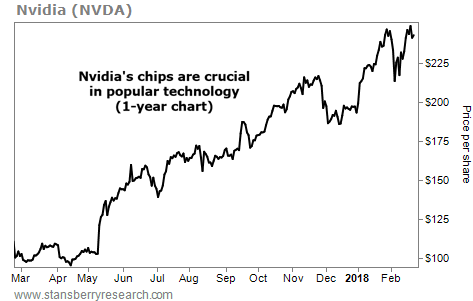| Home | About Us | Resources | Archive | Free Reports | Market Window |
Three Steps to Survive the Next 'Black Monday' CrashBy
Friday, February 23, 2018
When the next crash comes, they'll blame the machines. And they'll be wrong – again.
October 19, 1987 is known as "Black Monday." On that day, the Dow Jones Industrial Average lost more than a fifth of its value. The 22.6% drop was the biggest one-day percentage loss in history... even bigger than the crash of 1929.
What caused it?
The popular explanation is "portfolio insurance." This strategy used the futures market to try to protect a portfolio against a decline. I won't go into all the details today – but basically, it involved setting up a computer program to sell stocks automatically as the market went lower.
No one was taking the time to look at the fundamentals of the individual stocks. And so, the theory went, selling snowballed out of control and led to that big decline in 1987.
Now, most people take the "portfolio insurance" story as a given. (The Financial Times matter-of-factly declared it "a leading contributor to the 1987 'Black Monday' crash.")
I say the theory is bunk.
Today, I'll show you why... And I'll share three steps you can take that will help you get through market crashes (regardless of their causes) better than most everyone else...
The portfolio insurance theory has some big holes in it, as one Wall Street observer noted:
This quote comes from a book titled Ubiquity: Why Catastrophes Happen by science writer Mark Buchanan. In it, he covers catastrophes of all kinds – earthquakes, wars, and yes, stock market crashes. We always have ready explanations for these big events after they happen. But Buchanan uses insights from physics to show that "all past efforts to perceive cycles, progressions, and understandable patterns of change in history have necessarily been doomed to failure."
One of his most memorable examples involves using a simple sand pile to try to find out what causes an avalanche. If you take a grain of sand and then pile another grain of sand on top of it and another and another... How long before the pile collapses? What triggers it?
Three physicists from Brookhaven National Laboratory tried to answer this question in their lab. They ran lots of tests. And what did they find?
They found there was no way to predict an avalanche, or its size. There was no pattern. Sometimes the avalanches would be small, sometimes large. It seemed any grain of sand could trigger an avalanche at almost any time.
Buchanan writes:
In other words, triggers are unpredictable... Buchanan adds more evidence in a variety of fields to reach "the surprising conclusion that even the greatest of events have no special or exceptional causes."
This is hard for most people to swallow. They want a reason for why something happened. They want to have a theory. But most things happen for reasons we don't understand.
When the 1987 crash happened, I was 15 years old. I remember being intrigued by the whole thing, but not really understanding what was going on. The mystery of the crash helped fuel my interest in finance – and stocks specifically.
In the ensuing 30 years, I've lived through many more market catastrophes. They're never easy to get through. Here are three steps to help you:
If you follow these three key points, you'll get through better than most everyone else. Regards,
Chris Mayer
Further Reading:
"Most people spend too much time and energy trying in vain to predict the stock market," Chris says. He explains why this approach doesn't work for investors – and how to shift your focus to get better results today – right here: The One Secret to Thriving in 2018.
No one has a crystal ball... But you can still arm yourself for a possible catastrophe. In a recent essay, Kim Iskyan shares his best tips for protecting your finances ahead of time. Read more here: Six Ways to Get Ready for the Next Crisis – Before It Strikes.
Market NotesA TECHNOLOGY COMPANY FUELING BROADER TRENDS Today, we check in on another "picks and shovels" company behind a booming trend...
"Picks and shovels" businesses provide essential products and services to soaring industries. It's like selling drills during an oil boom – or selling picks and shovels in the middle of a gold rush. These stocks rise with their entire sector. And that makes them much safer than betting on a single company to win the trend.
Nvidia (NVDA) is a prime example of this. It makes graphics processing units ("GPUs"), which are crucial to several high-demand tech niches. Most people use these chips through video games and smartphones... But they're even used to mine for cryptocurrencies like bitcoin. Nvidia has boomed with these tech trends. Two weeks ago, the company reported record revenues for the year: $9.7 billion, up 41% from last year.
The chart below shows share prices are rising, too... The stock is up nearly 120% over the past year. It recently hit record highs. As interest in video games, mobile devices, and bitcoin continues to grow, expect Nvidia to benefit from its essential role behind the scenes...
 |
Recent Articles
|



